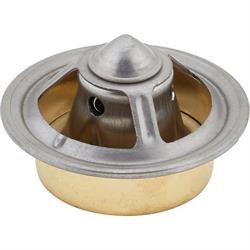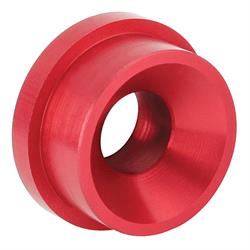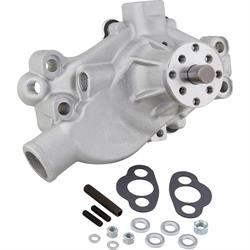Fix An Overheating Race Engine | Beyond The Cooling System
Why is My Car Overheating?
Maintaining optimal engine temperature is crucial for the performance and longevity of race cars engines, and overheating is a major cause of DNFs and engine failures. We'll discuss the various causes of engine overheating including going beyond the cooling system, providing targeted solutions to keep your race car running at optimum temperature. We'll cover some basics of the cooling system, but we'll show you how to detect and resolve issues related to engine tuning, proper ignition timing, air/fuel ratio, and water pump pulley ratios. By addressing these factors, racers can ensure their engines remain cool to get you across the finish line!
One of the first things you can examine is: at what point is your engine overheating? Does it happen during the race or during a yellow flag? The radiator must have air moving through it to carry away the heat, so if you’re fine during the green, but overheat during the yellow flag the issue is usually related to airflow. So let's get some obvious issues out of the way first:
- Obstructions: Obviously mud can restrict airflow - keep your radiator and the air flow clean. Rock guards and air dams can fill up with mud and debris. While you're scraping off all that extra weight, make sure you get in underneath and there's a clear path to the radiator.
- Are the radiator fins damaged? Radiator fins are easily bent by rocks and mud and prevent air from traveling across the cooling tubes. Fortunately they can be bent back easily.
- Radiator damage: Hits from rocks or mud can bend cooling tubes inside. Have you been in a previous wreck? Shock from impact may break epoxy or welds, causing leaks or lack of pressure holding capability which may not be visible at first glance. Your radiator may need to be pressure tested.
- Is your cooling system up to the challenge: Stock radiators may not be able to handle the demands of a race engine. Look to purpose built dirt track radiators for race-proven cooling options.
- Water pump: a leaking water pump has most likely failed. Gaskets that are worn are introducing inefficiencies or air in your water system. Low volume pumps may not produce enough flow for a high-powered engine. We have a water pump solution that will meet the demands of racing. Using a coolant additive, even with plain water can help prevent bubbles on the surfaces inside your cooling system and inhibit corrosion.
So what happens when you have already checked the radiator, the water pump, and all the hoses but the car is still running hot under a green flag? If we look at the source, a stock engine produces about 42 BTU per horsepower and a performance engine even more. When a vehicle is overheating and you have new components in the cooling system, it’s time to start pointing your finger somewhere else. The engine may be creating too much heat due to factors other than the cooling system.
Can Lean Fuel Mixture Cause Overheating?
A proper air/fuel ratio (AFR) will help your engine run cool and to its full potential. Some overheating issues are related to a lean air fuel mixture. For oval track racing, maintaining the right AFR is essential for performance and engine longevity. Here’s what you need to know: Stoichiometric Ratio: The stoichiometric AFR, which is 14.7:1 for gasoline, is where the fuel is burned completely with the available oxygen. This is a perfect-world condition though. This ratio is too lean for racing applications. A slightly richer mixture is preferred in racing to ensure cooler combustion and to maximize power. An AFR between 12.5:1 and 13.0:1 is commonly used in oval track racing.
As a result, a lean air fuel mixture means there is too much air and not enough fuel in the combustion process. When you have an air fuel mixture too lean this causes the cylinders to run hotter. This leads to higher combustion temperatures because the amount of fuel, which helps cool the combustion chamber, is insufficient. As a result, less fuel leads to hotter combustion temperatures and a hotter engine. Symptoms of a lean engine include:
- Lack of Power
- Difficulty starting
- Stalling
- Backfires under high throttle
Some causes of a lean engine:
- Carb jetting: If you've tried to lean the car out, look at returning to a starting point here. For example, Chevrolet recommends a #73 jet as the starting point.
- Fuel Pressure and Fuel Pumps: On most carbureted 602 and 604 crate race engines, fuel pressure typically ranges between 6 and 8 psi at all speeds. It’s important to maintain that pressure under all load conditions, because if it drops off at higher rpms, you run the risk an air fuel mixture too lean.
- Fuel bypass allowing too much fuel to be returned: on a fuel-injected methanol fueled sprint car, too large of a diameter pill in the main bypass allows too much fuel to be returned to the tank, if you're trying to cool the engine with fuel, you could need to richen the mixture with a smaller diameter pill.
- Fuel Filters: Clogged or defective fuel filters can restrict flow, causing an engine to run lean.
Race-ready fuel pumps and a correctly tuned and jetted carburetor or fuel injection system with proper filtering is a must for proper fuel efficiency and to prevent lean conditions.
Can Timing Cause Overheating?
Incorrect timing can lead to overheating. If the spark occurs to soon or too late, the cylinders will run too hot for differing reasons. If the spark happens too soon, the engine fights against mechanical cylinder pressure coming up, this additional pressure produces additional heat in the cylinder. On the opposite side, when the spark occurs too late the compressed air/fuel mixture is still burning when the exhaust valve opens, creating more heat in the system. Bad ignition timing symptoms include:
- Knock or pinging: suggests timing too far advanced, the mixture is firing too early and causing premature combustion.
- Poor performance: retarded timing can lead to fuel mixtures not being burned completely with gases that could be driving the piston down for power being wasted as exhaust.
- Hard Starts: advanced timing makes the engine resist turning over; retarded timing hinders ignition.
- Rough idle: as the word timing implies, bad timing can cause disruption in the whole system leading to a rough idle.
Use a timing light gun to verify your timing settings are correct. The optimum ignition spark timing will vary with engine speed, load, and air/fuel mixtures. And the correct ignition timing involves more than just setting the initial timing; the amount and rate of the mechanical and vacuum advance curves are also very important to avoid overheating. This is because cylinder pressure is much higher at wide open throttle than at midrange. The lower the cylinder pressure is, the more time it takes to complete the combustion process. Check the timing belt/chain, distributor cap, or magneto, ignition box, rotor, spark plugs and coils for wear or faults and replace as needed. Check out this article about advancing vs retarding ignition timing from UTI to learn more about this subject.
Can Water Pump Pulley Size & Ratio Cause Overheating?
In oval track racing, the size and ratio of your water pump pulleys can significantly impact your car's cooling system and potentially cause overheating. Understanding how pulley size and drive ratio affect coolant flow is crucial for maintaining optimal engine temperatures.
- Water pump pulley size directly influences the pump's speed. A small pulley increases the pump's speed, enhancing coolant flow at low RPMs but risking cavitation—air bubble formation—at high RPMs, which can reduce cooling efficiency. Conversely, a large pulley decreases the pump speed, preventing cavitation at high RPMs but potentially leading to inadequate coolant flow at low RPMs.
- Pulley drive ratio, which is the relationship between the crankshaft pulley and the water pump pulley, also plays a pivotal role. A higher drive ratio results in a faster-spinning pump, while a lower ratio slows it down. Overheating at high RPMs can occur if the pump spins too quickly due to a small pulley, leading to cavitation. To address this, using a larger pulley can help slow down the pump. On the other hand, overheating at low RPMs might happen if the pump spins too slowly because of a large pulley, which can be mitigated by using a smaller pulley.
- For optimal performance with gas engines, it's recommended to use a 1:1 pulley ratio like our Aluminum 1:1 Pulley Combo for SBC. This is a great starting point for your accessory belt drive and to prevent SBC overheating issues and are ready to install directly onto 602 & 604 crate engines. Alcohol/Methanol engines don't need as much coolant as the fuel helps cool the engine and can run a lower pulley ratio. Regularly monitoring engine temperatures and adjusting the pulley size and ratio as needed is essential.
Can a Radiator Fan Cause Overheating?
Radiator fans are essential for preventing overheating, ensuring the engine's temperature is maintained by promoting proper airflow through the radiator, especially at low speeds or when idling. But, you need to be using the right fan for the purpose, and using the fan system to maximum efficiency with parts like dedicated mechanical race fans, and radiator shrouds.
- Using a proper fan: Stock fans, even if they were pulled from a heavy-duty junkyard truck are not designed for the demands of a race engine. More air volume is needed. Racing mechanical fans are designed to continue to pull a high volume of air, without flexing, through the radiator while balancing the effects of drag and still remaining lightweight. Using the right size fan is also important. Most modifieds use a 15-17" fan, while Late Models and Street Stocks will use a 18-19" fan.
- Fan shrouds help airflow: A fan shroud will guide airflow through the radiator more effectively, improving the overall cooling efficiency. The positioning of the fan shroud is crucial; if the fan is too far from the radiator, it can cause turbulence and reduce cooling efficiency. Ideally, the fan should be positioned so that about two-thirds of it is inside the shroud, with the blades within 1 inch but no more than 2 inches away from the radiator. This setup maximizes airflow without causing unnecessary turbulence, ensuring peak efficiency. For more information about the effects of a fan shroud and selecting the correct fan and shroud, check out our article Does a Fan Shroud Make a Difference.
Checking Your Engine for a Faulty Thermostat
First, it helps to answer the question, what does an engine thermostat do? It is quite simple: An engine thermostat regulates coolant flow to maintain the engine's optimal operating temperature, ensuring efficient performance and preventing overheating. It aids in quick warm-up, and maintains a consistent engine temperature. The thermostat remains closed when the engine is cold allowing the engine to build up heat and opens once the engine reaches the thermostat's specified temperature, allowing coolant to flow to the radiator, where the coolant is cooled to optimum temperature.
Testing car thermostats is an easy process without pulling out the thermostat using a simple Laser Infrared Thermometer. Technically, this tool is a Pyrometer since it measures temperatures from a distance, as opposed to a thermometer that measures temperatures while in contact with the substance, but the two terms are often used interchangeably. An infrared laser pyrometer is a great racing tool as it's often used to check tire temperatures after coming in from a race or warmup session. To check whether or not a radiator thermostat is functioning correctly with a Laser Infrared Thermometer follow these steps:
- With a cold engine, start the car.
- Locate the thermostat: typically in the housing where the upper radiator hose connects to the engine.
- Let the engine reach operating temperature, typically 10-15 minutes at idle.
- Use the IR thermometer to measure the temperature at the thermostat housing.
- Also, measure the temperature at the upper radiator hose, close to where it connects to the thermostat housing.
- A properly functioning thermostat will open at its specified temperature (usually between 180-195°F or 82-91°C).
- Before the Thermostat Opens: The temperature at the thermostat housing will be high, while the temperature at the upper radiator hose will be significantly lower.
- After the Thermostat Opens: The temperature at the upper radiator hose should increase and eventually match the temperature at the thermostat housing as the coolant flows through.
Diagnosis to detect a faulty thermostat
- Engine Thermostat Opening Properly: If you observe the expected rise in temperature at the upper radiator hose when the engine reaches the thermostat's specified opening temperature, the thermostat is functioning correctly.
- Engine Thermostat Stuck Closed: If the temperature at the thermostat housing is high but the temperature at the upper radiator hose remains significantly lower and does not rise, the thermostat might be stuck closed, preventing coolant from circulating.
- Engine Thermostat Stuck Open: If the temperatures at both the thermostat housing and the upper radiator hose rise together gradually and the engine takes longer to reach its normal operating temperature, the thermostat might be stuck open, causing continuous coolant flow.
Aside from a defective or damaged thermostat, if you have an engine thermostat not working, consider getting a race-specific thermostat designed to accommodate high-flow systems. Our High Flow Thermostat, 180 Degree rated is strongly recommended for any performance application, with high RPM/high flow in mind
Can You Drive a Car Without a Thermostat? | Coolant Restrictor vs. Thermostat
Can no thermostat cause overheating? Driving a race car without a thermostat and using a coolant restrictor instead is a topic that requires understanding the functions and benefits of each component. Here's an in-depth look into the benefits and drawbacks of a thermostat restrictor plate vs actual thermostats.
Coolant Restrictor vs. Thermostat
- Thermostats regulates the flow of coolant based on the engine's temperature, opening and closing to maintain an optimal temperature range. It helps maintain a consistent engine temperature, which is crucial for optimal performance and longevity. By controlling the coolant flow, it prevents the engine from overheating and aids in faster engine warm-up, improving fuel efficiency and reducing emissions. However, removing the thermostat entirely can lead to prolonged engine warm-up times. Without a thermostat, coolant flow can become inconsistent, potentially leading to overheating under certain conditions.
- Coolant restrictors reduce the flow of coolant to specific areas of the engine. It is typically used in high-performance applications to balance temperatures between cylinders. The pressure inside your block is increased, which helps to prevent steam pockets. The thermostat restrictor helps maintain more uniform temperatures across the engine, which is especially important in racing where temperature balance is critical. In racing scenarios like oval track racing, where precise temperature control is necessary, restrictor plates may be preferred over thermostats, since they allow for fine-tuning the engine's thermal dynamics to achieve optimal performance.
Swapping a thermostat for restrictor plate is not a guaranteed solution for correcting an overheating engine. While a thermostat restrictor plate can help balance temperatures in certain racing applications, it may not address the underlying issues causing overheating. While driving a car without a thermostat is possible using a coolant restrictor, it may not be the choice for optimal engine performance. The choice between a thermostat and a restrictor plate depends on the specific needs of the engine and the racing conditions. Proper diagnosis and addressing of any cooling system issues are crucial before considering such a swap to prevent overheating.
Preventing overheating in a race engine sometimes goes beyond just the cooling system. Addressing factors such as airflow, lean air/fuel mixtures, improper ignition timing, thermostats/coolant restrictors, and water pump pulley size and ratios is crucial. Regular maintenance and careful monitoring of these elements can help ensure optimal engine performance and longevity. By understanding and resolving these issues, racers can maintain cooler engines, reduce the risk of damage, and improve their chances of success on the track. And remember, Speedway Motors has all the Dirt Racing Parts you need to get you to the finish line!









